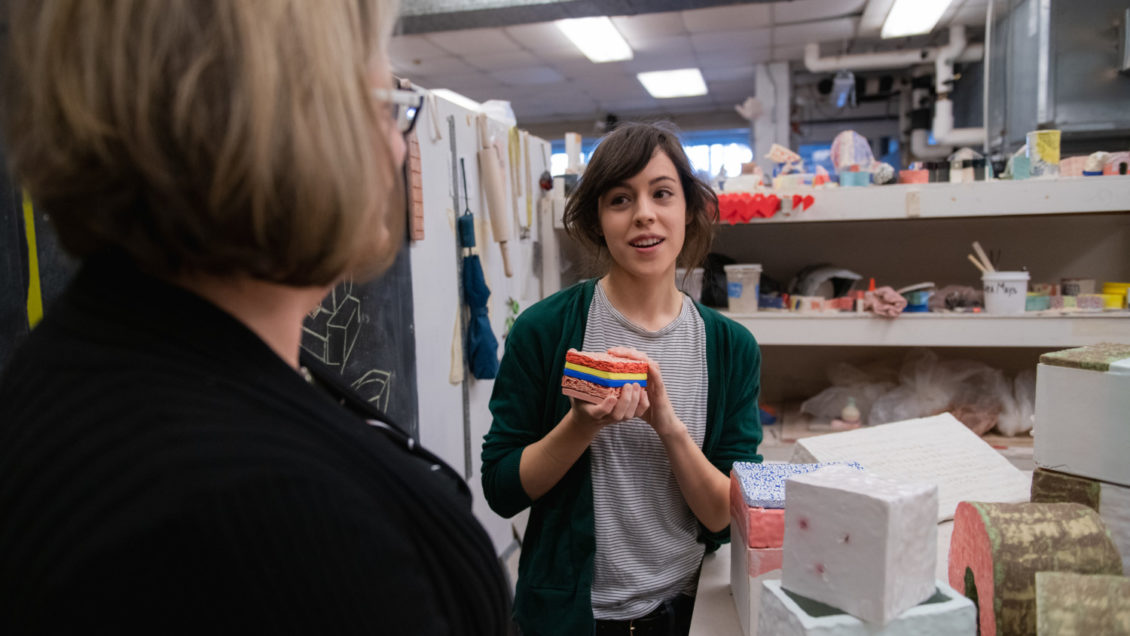If you’re looking for Sara Mays, you’ll find her in the basement of Lee II. That’s where the graduate visual arts studios are found.
Mays’ studio features floor-to-ceiling shelves covered in hand tools, art materials, books and completed ceramics. On one of these shelves sits a series of multicolor cubes. Each cube is constructed of pressed layers of clay slabs and are painted in red, yellow and blue. Textured patterns call from their otherwise smooth surfaces.

“I like to make things people can touch but also make things that people cannot touch but feel like they really want to. I want the viewer to really engage with their other senses when they see my work,” Mays said.
This particular artwork was produced as part of Mays’ participation in the Community Supported Art program (CSArt) Spring 2018. Modeled after Community Supported Agriculture — a symbiotic system in which consumers purchase a share of a local farmer’s crop — CSArt produces 15 shares of original, handcrafted art by student artists.
To ensure the quality of the artwork and give students a competitive, real-world experience, each piece is selected by a guest juror like Atlanta gallerist Yu-Kai Lin, who judged in Spring 2018. Shareholders range from Clemson administrators to private art enthusiasts, 15 of whom are now proud owners of one of Mays’ ceramics.
For Mays, CSArt is a win-win for both community members and student artists.
“With CSArt, you get to make what you love, you get paid for it, and other people get to enjoy and share it with others,” she said. “That’s all an artist really wants from life: for someone to appreciate their work as something really important and to be promoted for what they do.”
Department Chair and Associate Professor of Art Valerie Zimany founded the CSArt Creative Inquiry with students like Mays in mind.
“CSArt gives students access to the entrepreneurial and professional side of art,” Zimany said. “Some of these students are art majors. Others have an interest in the arts but envision having a life in a different discipline, so CSArt is a way of keeping a creative practice in their life.”
CSArt is open to all Clemson students. Past majors have included psychology, marketing, architecture and microbiology.
“I once had a student who applied to medical school and wrote their personal essay about CSArt and the importance of connecting communities,” Zimany said.

Like Mays, undergraduate visual arts major Hannah Horowitz is concentrating in ceramics. Unlike Mays, Horowitz hopes her experience as an artist will transfer to her professional goal of working in prosthetics. Horowitz is one of eight undergraduate researchers on the CSArt Creative Inquiry team and served as an alternate for last year’s selection of artists. Her responsibilities on the team include managing social media accounts, communicating with shareholders and running the CSArt website.
“CSArt has helped me develop my professionalism,” Horowitz said. “The Creative Inquiry is run as a small business, so looking professional and staying organized is important.”
Horowitz’s professionalism helped her this summer when she interned with the Greenville Health System Office of Prosthetics and Orthotics.
“I got to experience the business side of prosthetics,” Horowitz said. “Even though I’m an art major, I didn’t feel out of place. It was good to see how CSArt applies to what I want to do in the real world.”
Mays is still trying to find what she wants to do once she graduates. CSArt might help lead the way.
“Originally, I wanted to become an art teacher,” Mays said. “But now I think I might enjoy making work and selling it. I’d like to own my own studio, maybe a gallery.”
Whatever Mays’ career goals, Professor Zimany feels CSArt will help pave the path.
“CSArt offers a glimpse into the dynamic, workforce experience of a contemporary artist. This is something students can use in their professional lives,” she said.
Get in touch and we will connect you with the author or another expert.
Or email us at news@clemson.edu

